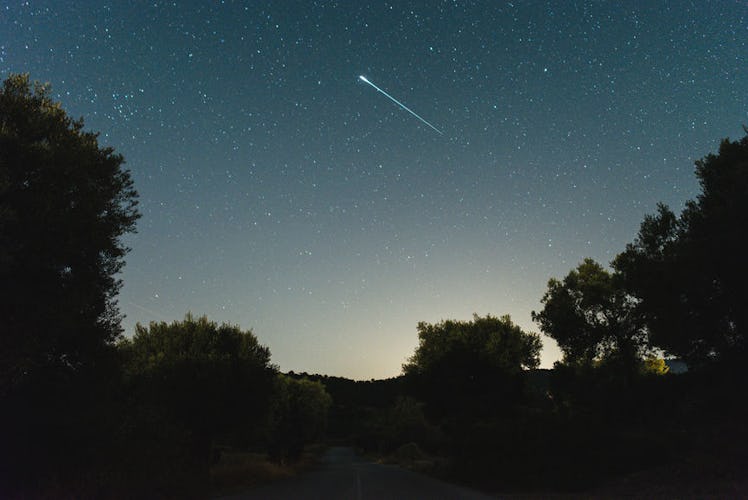
How To See The Leonids Meteor Shower So You Get A Chance To Wish On A Star
Are you in the mood to be wrapped up in some celestial magic? Could you use some help from the stars above? If daily life has been getting you down as of late, you're in for a cosmic treat, because one of the biggest and greatest meteor showers will soon be upon us. If you're an astronomy nerd, maybe you've already heard of it, but if you're simply in need of a reminder that the world we live in is ridiculously beautiful and packed to the brim with mystery, I promise you're about to become a nerd, too. Either way, you'll want to know how to see the Leonids meteor shower 2018, because make no mistake: The sky will be downright spectacular.
Whether you believe in magic or not, the Leonids are the perfect opportunity to wish on a shooting star. And yes, all you science geeks out there, we know that stars are not literally blasting through the sky. We're aware that shooting stars are technically called "meteoroids" and that they have nothing to do with stars whatsoever. As for me, I simply can't resist the enchantment of it all, and I will proudly be calling them "shooting stars" until the day I die. But, I digress, because this isn't about me. This is about you — and the amazing evening you're about to spend with the Leonids.
When Is The Leonids Meteor Shower 2018?
Before we get into all the starry details, you're probably wondering whether or not you'll even be available to see the Leonids in real time. Let's just cover that base first, shall we? Well, according to TimeAndDate.com, the Leonids will peak from Saturday, Nov. 17 to Sunday, Nov. 18. Luckily, this cosmic spectacular takes place on the weekend this year, but even if you're fully booked and you can't set aside time for the Leonids, keep in mind that they take place annually. There's always next year, right?
What Time Will The Leonids Meteor Shower 2018 Begin?
While there's no specific time that the Leonids will take place (after all, they've been sporadically shooting through the sky since Nov. 6, according to TimeAndDate.com), there are definitely better times to watch it than others. As stated by EarthSky.org, the best time to see the Leonids is anytime between midnight and dawn, so feel free to take an afternoon nap, grab a cup of coffee, and pull an all-nighter. It's all in the name of shooting stars.
Will The Leonids Meteor Shower 2018 Be Easy To See?
While cloudy and stormy weather can definitely impede the viewing of any meteor shower, one thing you should keep in mind is that there will be a waxing gibbous moon during the weekend of Nov. 17 and 18. Because the moon will be so bright, it might overpower the faint streaks of light that each meteoroid carries with it. It would be wise to double check when the moon will rise and set in your area, just in case you're able to sidestep the moon for the sake of the Leonids. TimeAndDate.com has a very reliable moonrise and moonset calculator here.
How Should I Prepare For The Leonids Meteor Shower?
Because our eyes are so used to large doses of artificial light, you should also spend at least 15 to 20 minutes allowing your eyes to adjust to total darkness before watching the Leonids, according to TimeAndDate.com. That way, your eyes will be trained to see even the faintest shooting star.
How else can you see this meteor shower more clearly? You should always go somewhere rural in order to see them. Highly populated cities almost always carry too much light of their own, making it difficult to see what's going on in the sky. It's the perfect excuse to go on a mini road trip and travel to the middle of nowhere.